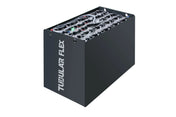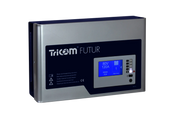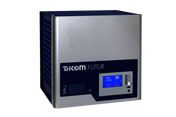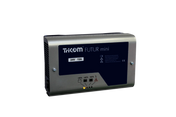If your forklift suddenly runs at half the speed, the temperature rises significantly during charging, and the battery starts bubbling, then it's time to take a closer look.
Many signs of a defective forklift battery are misinterpreted. Rather than a charger error, the battery itself is often the cause. However, "defective" doesn't automatically mean "replacement" – the battery can often be checked, reconditioned, or specifically repaired.
This guide shows you how to identify battery problems, check them professionally, and respond economically with targeted measures – from regeneration to cell replacement.
Typical signs of a defective forklift battery
The following symptoms indicate wear or damage:
- Fast discharge despite full charge
- Reduced forklift operating time
- Charging interruptions or no charging end – modern IUoU chargers detect the end of charging when the current drops to about 3% of the bulk current
- Excessive heat development – critical from 45–50 °C , maximum 55 °C according to manufacturer's specifications
- Gassing or bubbling due to over-acidification as a result of incorrect charging characteristic
- Corrosion or deposits on connections and housing
- Low electrolyte level despite regular refilling
- Unusual smell of sulfur or acid
Tip: If you experience these symptoms, first check the water level, voltage, and terminal connections . Contact problems or humid charging environments are often the root cause.
Causes of battery problems
The battery life depends heavily on care, temperature, and charging behavior. Common causes include:
- Deep discharge below 20% remaining capacity (SOC)
- Unsuitable chargers or missing IUoU regulation
- Irregular intermediate charges that cause cell stress
- Sulfation due to long periods of inactivity or incomplete charging
- Inadequate maintenance of water level and cleaning
- High ambient temperatures without voltage compensation
Professional battery diagnosis according to standards
A precise condition assessment is carried out by an operational test according to the standards DIN EN 60254-1 (static test) and DIN EN 60254-2 (cyclic test for traction batteries).
- Cell voltage under load – below 2.0 V a cell is considered weakened
- Static capacity test (according to Part 1) under constant discharge current
- Dynamic C5 test (according to Part 2) over 5 hours at 0.05 C – practical assessment
- Internal resistance and acid density to determine age and sulfation
- Insulation resistance > 1 MΩ according to DIN VDE 0117 – avoids leakage currents
End of charge detection and temperature compensation
Modern IUoU chargers automatically terminate the bulk charge when the current drops below approximately 3% of the original bulk current . This protects against overcharging and heat buildup. At ambient temperatures above 25°C, the charger reduces the voltage by approximately -3 mV/°C/cell to prevent gassing and corrosion.
Equalizing charge after deep discharge
After a deep discharge (< 20% SOC), an equalizing charge should be performed: approximately 2.6 V per cell for 2 to 4 hours , depending on the degree of sulfation. This corrects the acid stratification and restores cell balance .
Regeneration – instead of replacement
In many cases, a forklift battery can be regenerated. This involves dissolving sulfate crystals and adjusting the electrolyte and voltage levels. Depending on the condition , up to 80% capacity recovery is possible. HK Handels GmbH uses temperature-controlled charging processes and documented test cycles for this purpose.
Alternative: tested used batteries
If regeneration isn't practical, tested used batteries offer a cost-effective solution. These are remanufactured, tested, and delivered with a capacity certificate according to ISO 9001 – a clear distinction from untested used batteries.
Professional disposal and cell replacement
If the battery is irreparable, a specialist company will dispose of it in accordance with Section 10 of the German Battery Act (BattG) and issue a disposal certificate . In many cases, the battery's value is taken into account.
Cell exchange and documentation
If only individual cells are defective, a targeted cell replacement may be advisable. This must be documented in the test report – including serial numbers, batches, dates, and results of the equalizing charge. This documentation ensures traceability and warranty claims.
Maintenance and care for maximum service life
With consistent maintenance, the service life of a forklift battery can be significantly extended:
- Check water level regularly or use Aquamatik refill system
- Aquamatik maintenance : check for leaks and cleanliness at least once a year
- No deep discharge – recharge from 20% remaining capacity
- Use a suitable charger with IUoU characteristic curve
- Cleaning the connections and checking for corrosion
- Insulation test every six months according to DIN VDE 0117
Conclusion: Defect does not mean the end
A weak battery rarely means total failure. Testing, equalizing, regenerating, or replacing cells significantly extends its service life. This saves you money and ensures sustainability.
HK Handels GmbH supports you with diagnosis, regeneration and maintenance – professionally, documented and environmentally friendly.







